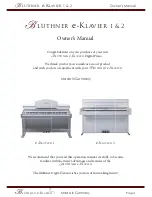
ABL90 FLEX reference manual
Appendix – Traceability to the primary standards at Radiometer
II-5
The primary working standard used is a whole-blood sample, with the
c
tHb
value adjusted to between 13 and 15 g
%
. The blood sample is tonometered
with 5.6
%
CO
2
- 94.4% O
2
, traceable to NIST SRM gases.
The primary standard is used to calibrate the ABL735 reference instruments.
The primary working standard used is a whole-blood sample. The blood sample
is centrifuged and the resultant blood concentrate is deoxygenated using Argon
and treated with a dithionite solution.
The primary working standard is used to calibrate the ABL735 reference
instruments.
The primary standards used are CO with atmospheric air mixtures, produced in
a container of known volume. The CO used for making these gas mixtures has a
certified purity of 99.997 %. Validation of the mixing method is done by
comparison with NIST SRM 1678 (50 ppm CO in N
2
).
The produced mixtures are used as calibration standards in connection with a
gas chromatography method. The gas sample, injected into the gas
chromatograph, is the headspace of a blood sample which has been treated so
that all the bound CO is released from the hemoglobin. The analyzed result is
measured in
%
CO, and from this the
F
HbCO is calculated. The method is
described in Ref. 6.
The measured blood sample is used as secondary standard and is used to
calibrate the ABL735 reference instruments.
The primary working standard used is a whole-blood sample. The blood sample
is tonometered with 100
%
CO, with a certified purity of 99.997
%
CO. The
primary working standard is used to calibrate the ABL735 reference
instruments.
The primary working standard is a whole-blood sample. The
F
MetHb is
determined using the KCN addition method according to Evelyn and Malloy (Ref.
7). This method is a spectrophotometric method, where the absorbance
measurements are done at 630 nm (local peak for MetHb) on two sets of
solutions, prepared from the whole-blood sample. The first set allows
determination of the relative MetHb content, whereas
c
tHb is determined from
the second set. From these measurements, the
F
MetHb of the whole-blood
sample can be calculated.
The primary working standard is a whole-blood sample. The FHbF of this sample
is determined using the Cation Exchange HPLC reference method. The method is
described in [Ref. 9]. The method is performed by the Hæmatology Laboratory
at Herlev Hospital, Denmark.
Reference method
Radiometer uses a reference method based on the packed-cell-volume
procedure described by the Clinical and Laboratory Standards Institute (Ref.
10). The packed-cell volume is the measure of the ratio of the volume occupied
by the red cells to the volume of whole blood in a sample of capillary or venous
blood. The ratio is measured after appropriate centrifugation.
Saturation –
sO
2
= 100 %
Saturation –
sO
2
= 0 %
FCOHb –
normal value
FCOHb –
100 %
FMetHb
FHbF
Hct
Summary of Contents for FLEX ABL90
Page 1: ...ABL90 FLEX reference manual ...
Page 2: ......
Page 3: ...ABL90 FLEX reference manual ...
Page 4: ......
Page 124: ...3 Wet section ABL90 FLEX reference manual 3 10 ...
Page 125: ...4 Electronics General information 4 2 Electronic boards and components 4 3 ...
Page 216: ...7 Performance characteristics ABL90 FLEX reference manual 7 30 ...
Page 263: ...9 Solutions General information 9 2 Solutions 9 3 Certificate of traceability 9 5 ...
Page 267: ...ABL90 FLEX reference manual 9 Solutions 9 5 Certificate of traceability ...
Page 268: ...9 Solutions ABL90 FLEX reference manual 9 6 ...
Page 269: ...10 1 10 Messages List of analyzer messages 10 2 ...
Page 310: ...10 Troubleshooting updated for software version 2 3 ABL90 FLEX reference manual 10 42 ...
Page 326: ...Appendix Quality control ABL90 FLEX reference manual I 16 ...
Page 327: ...II Appendix Traceability to the primary standards at Radiometer ...
Page 334: ...Appendix Traceability to the primary standards at Radiometer ABL90 FLEX reference manual II 8 ...
















































